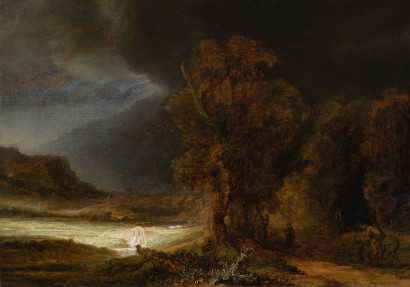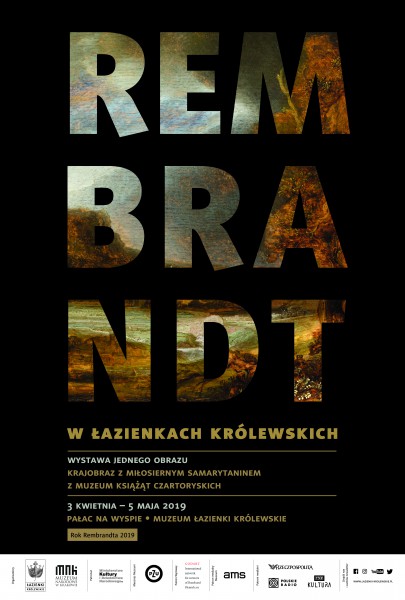

Masterpiece of landscape art by Rembrandt and one of only three confirmed works by the master in Polish collections. The "Landscape with the Good Samaritan" from the Czartoryski Princes’ collections will be put on display in the Royal Łazienki from 3 April to 5 May 2019.
The exhibition of the "Landscape with the Good Samaritan" is the result of cooperation between the Royal Łazienki Museum and the National Museum in Kraków, where the painting is normally held. The 17th-century masterpiece by Rembrandt, one of the greatest artists in history of art, will be put on display in the Palace on the Isle.
3–30 April: Tuesday–Wednesday, 9.00–16.00; Thursday, 10.00–20.00; Friday–Sunday, 9.00-16.00; admission: PLN 25 – normal ticket, PLN 18 – reduced price; on Thursdays, entry is free of charge. 1–3 May, 10.00–20.00, entry free of charge. 4-5 May, 10.00–20.00, entry – PLN 1.
Rembrandt’s Landscape Masterpiece
The "Landscape with the Good Samaritan" is one of the most valuable works of European art in Polish collections and one of only three confirmed original works by Rembrandt in Poland. The other two – "The Girl in a Picture Frame" and "The Scholar at the Lectern" (both from 1641) – are currently owned by the Royal Castle in Warsaw.
The masterpiece of landscape art by Rembrandt came into being 1638. Its themes allude to the parable of the Good Samaritan from the Gospel of St. Luke. The painting is not a faithful illustration of the biblical story, but rather its interpretation, closely connected with the depicted landscape. The landscape on which the scene takes place – composed of various elements, both local (Dutch flatlands, windmills, stone bridge, farm buildings on the edge of the forest), and exotic (mountains, oriental city with copulas, palm tree in the clearance of the road) – is rooted in the tradition of 16th-century Flemish landscape painting. The scenery presents itself as a great theatrum mundi – theatre of the world, where the timeless tragedy of human life plays out. The figures depicted in the paintings are not simply characters from the Biblical parable, but also an integral part of the landscape.
The “Landscape with the Good Samaritan" – What Does it Depict?
The group of massive oak trees in the foreground divides the composition into two disproportional parts. Broad plains stretch out on the left side, enclosed – in the distance – by hills and oriental town buildings. It is most likely the Biblical Jericho, whose walls are lined up with a row Dutch windmills. On the plains, brightly illuminated by the strong sunlight, shining through the clouds that are swayed by the wind, one can discern small figures of people working in the fields, a fisherman at work, animals – horses and cows, as well as ruins of a tower.
To the right is the dark wall of the forest on the edge of which runs a road, leading into the valley, in the direction of the stone bridge on the river. On the road travels a wealthy man in a coach pulled by four white horses; on the turn of the road are two small figures – presumably silhouettes of the priest and the Levite. Behind the road, among the trees, one can see tavern structures. To the right, beneath the oak trees, stands a hunter with his gun aimed upwards, likely hunting for birds, in the company of a boy. On the left side of the road, near the forest, stands a pair of smartly-dressed people frozen in an embrace and, and – as it seems – terrified – perhaps having witnessed an assault on the traveller.
On the right side, in the corner of the painting, in the foreground, a half-naked, wounded man sitting on horseback is held up by a Samaritan, whose head, wrapped in a turban, can be discerned above the horse’s head. The wounded and the Samaritan are joined together, seemingly forming a single figure – a symbol expressing the essence of compassion.
"Landscape with the Good Samaritan" – Interpretation
There have been attempts to interpret the "Landscape with the Good Samaritan" in symbolic terms, e.g. as a reference to the Christian soul, which must traverse a world filled with sin and temptation in order to reach eternal salvation.
In various elements of the painting, the viewer can make out symbolic meanings prevalent in 17th-century Dutch painting. Rembrandt was, however, too great of an artist to reduce the message of his work to a mere collection of symbols. Judging by the compositional aspects of the painting – where he introduced a set of elements drawn from different sources and traditions, in order to create an entirely new whole – we should assume that he also aimed to present the textual meaning of the painting in a way as to convey his personal attitude towards Christ’s parable, and to rediscover it.
Rembrandt in the Czartoryski Family Collections
The "Landscape with the Good Samaritan" was bought by Jean Pierre Norblin de la Gourdaine at an auction held by Vassal de Saint-Hubert in Paris on 17 January 1774, shortly before he travelled to Poland. The French painter and sketch artist subsequently spent three decades of his life working as a court painter of Adam Kazimierz Czartoryski – uncle of Stanisław August, and his wife. The collections of Izabela Czartoryska née Flemming, assembled since approx. 1800 in Puławy – in the Temple of the Sybil and the Gothic House – laid the foundations for the future Princes’ Czartoryski Museum.
Collections of Stanisław August
The early 1770s were also a period of exceptionally frequent purchases by Stanisław August on the west-European art market. "The Girl in a Picture Frame" and "The Scholar at the Lectern" by Rembrandt – gems of the royal collections, came to Poland from Berlin in 1777, bought from the Kamecke counts. The royal collections were made up of works by prominent Flemish, Dutch, French, Italian and German painters from the 17th and 18th century. According to the inventory of 1795, Stanisław August owned 2478 works by artists including: Rembrandt van Rijn, Angelika Kauffmann, Per Krafft, Anton van Dyck, Nicolas de Largillière, Gabriel Metsu and Marcello Bacciarelli (some of these works are currently displayed in the Palace on the Isle). Thus was born one of the largest collections of paintings in the 18th-century Polish Republic.
The exhibition of the painting – the "Landscape with the Good Samaritan" is accompanied by an educational programme, which will feature three lectures held in the Royal Łazienki.
4 April 2019, 18.00, Palace on the Isle
"Pejzaż z miłosiernym Samarytaninem Rembrandta. Ikonografia i teologia" (Landscape with the Good Samaritan by Rembrandt. Iconography and Theology), Bishop Professor Michał Janocha.
11 April 2019, 18.00, Palace on the Isle
"Krajobraz Rembrandta z kolekcji książąt Czartoryskich – o jego historii i próbach interpretacji" ("Landscape with the Good Samaritan by Rembrandt – Its History and Attempts at Interpretation"), Dorota Dec, National Museum in Kraków.
16 April 2019, 18.00, Palace on the Isle
"Pejzaże Rembrandta: psychologizacja natury, studia warsztatowe czy towar na sprzedaż?" ("Landscapes by Rembrandt: Psychologisation of Nature, Exploration of Craft, or Product for Sale?"), Professor Antoni Ziemba (National Museum in Warsaw).
The exhibition of the painting by Rembrandt is held under the patronage of the Ministry of Culture and National Heritage. Museum and exhibition patrons: PZU; exhibition patron: Codart; media partners: AMS, Polskie Radio, TVP Kultura, Rzeczpospolita.
